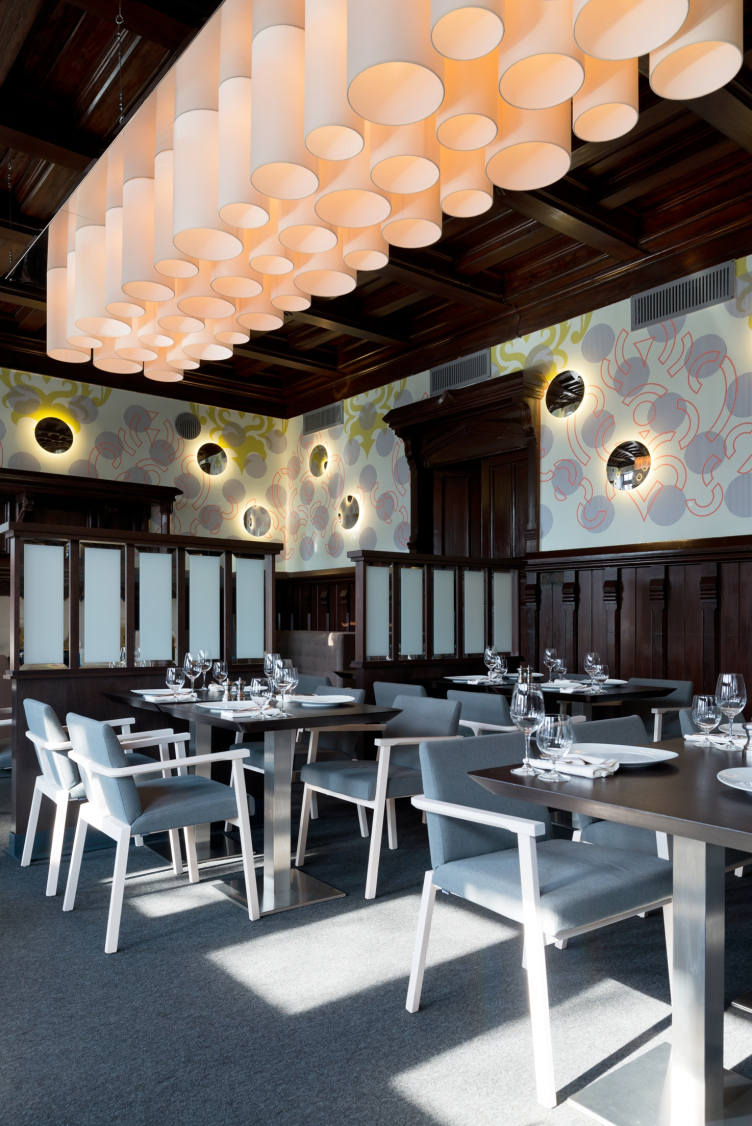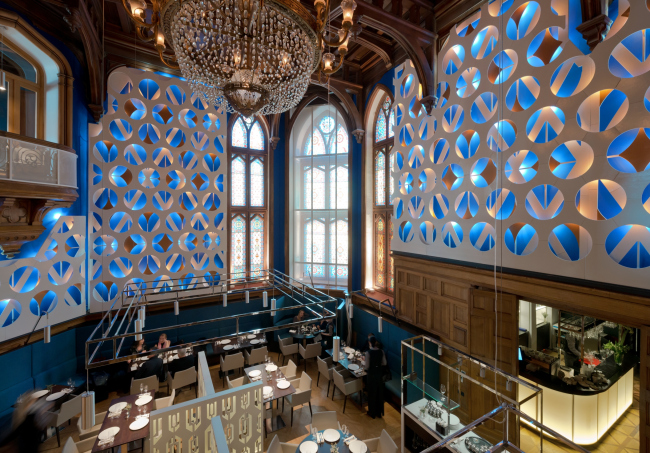
Reconstruction of the restaurant of the Central House of Writers © WOWHAUS
The restaurant of the Central House of Writers appeared in the 1930's as a cafe of the Writers' Union that was then occupying the Olsufievs Mansion built back in 1886–1887. This place gained an almost instant popularity: the famous writers not only dined here but also read their manuscripts, celebrated their birthdays, and had heated discussions as well. The walls of the CHW remember Tvardovsky, Zoschenko, Sholokhov, Okudzhava, as well as Nils Bor, Marlene Dietrich, Indira Gandi, and many other celebrities. After the fall of socialism, the restaurant for years retained the heavyweight aura of the stagnation era: it was quite an expensive place to eat in, and the interior "supported" the sky-high prices with the brazen luxury of the velvet curtains and oak panels. When the restaurant changed its owner last year, the issue of renewing its "face" was instantly raised. Developing a new groundbreaking gastronomic concept for the CHW, the restaurant owner Aleksey Zimin turned to WOWHAUS Bureau with a request to design a bright and dramatic but at the same time easily replaceable interior that would be oriented for the new clientele of the restaurant - workers of the creative industries aged from 25 to 45.
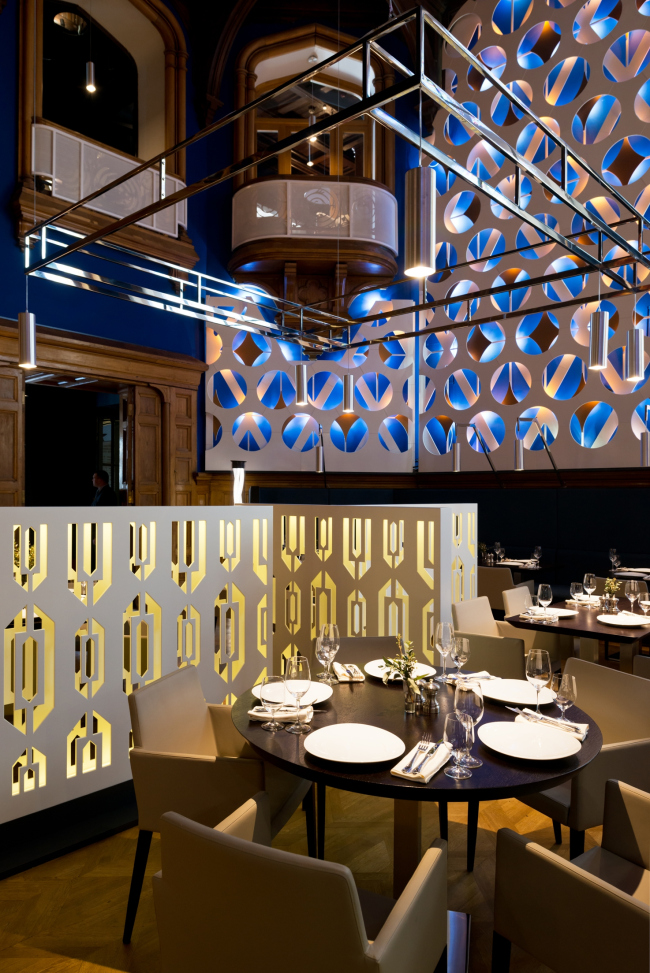
Reconstruction of the restaurant of the Central House of Writers © WOWHAUS
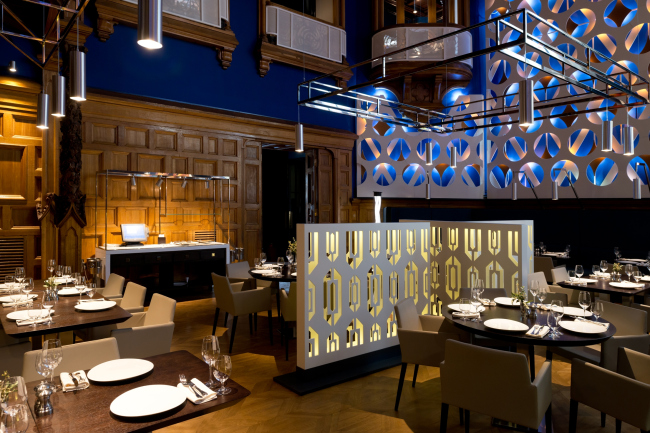
Reconstruction of the restaurant of the Central House of Writers © WOWHAUS
The challenge of this task consisted in the fact that the new design was not supposed to "cross out", let alone oust, the historical adornment. The monument architecture and just a milestone place of the nation's culture were to be kept completely intact, this is why all the authentic elements of the neogothic interior - the oak panels, the fireplaces, and the chandeliers (including the one that was originally going to become the jewel of "Komsomolskaya" Hotel) - were all in one bunch transferred into the project of its renovation, in fact, even before the moment that the architects actually got down to work. "The solution just what to do with all these things came to us rather soon - shares Dmitry Likin, partner of WOWHAUS. Due to the fact that nobody performed a fully-fledged historic and restoration inspection of the building's interior, any serious intervention could have possibly led to damages. It was decided to act in accordance with the logic of art-intervention - meaning, to put a new layer upon the old interior. It will switch the guest's attention onto itself, it will create a different atmosphere but, should this be necessary, it can be easily changed or even removed".
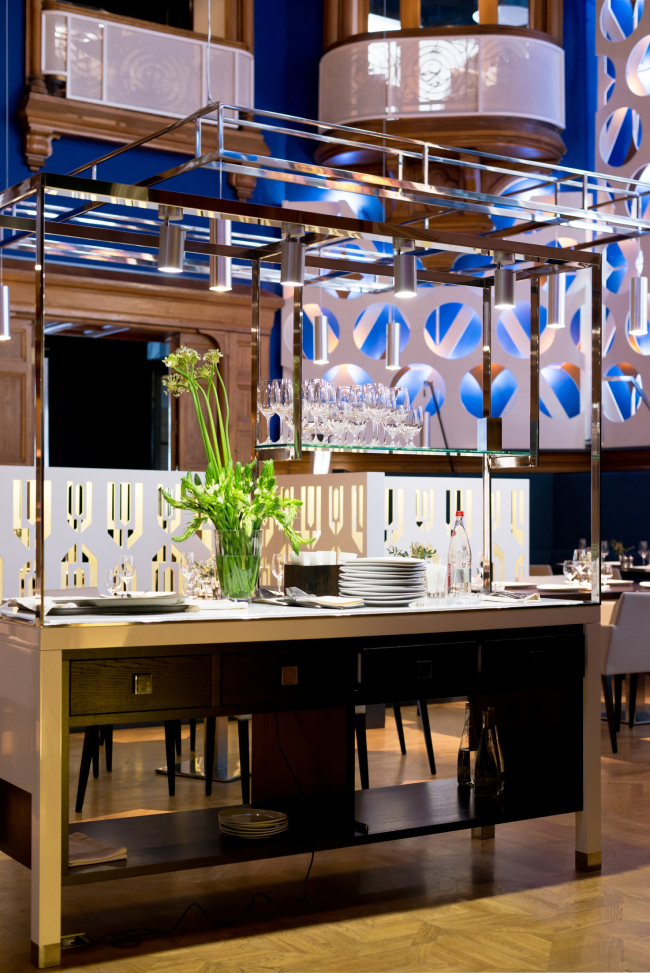
Reconstruction of the restaurant of the Central House of Writers © WOWHAUS
In other words, the choice was at once made in favor of several quick-mount materials - namely, gypsum plasterboard and MDF that, if needed, could be dismantled literally overnight. It is these materials that create in the historical interior the contemporary "layer" treating the originally set neogothic theme through the ornament and light-and-color effects. "The new image of the restaurant is based on the contrast of the interior's historical details executed from wood and the technologies that create a composition that is resonant of today" - Oleg Shapiro adds.
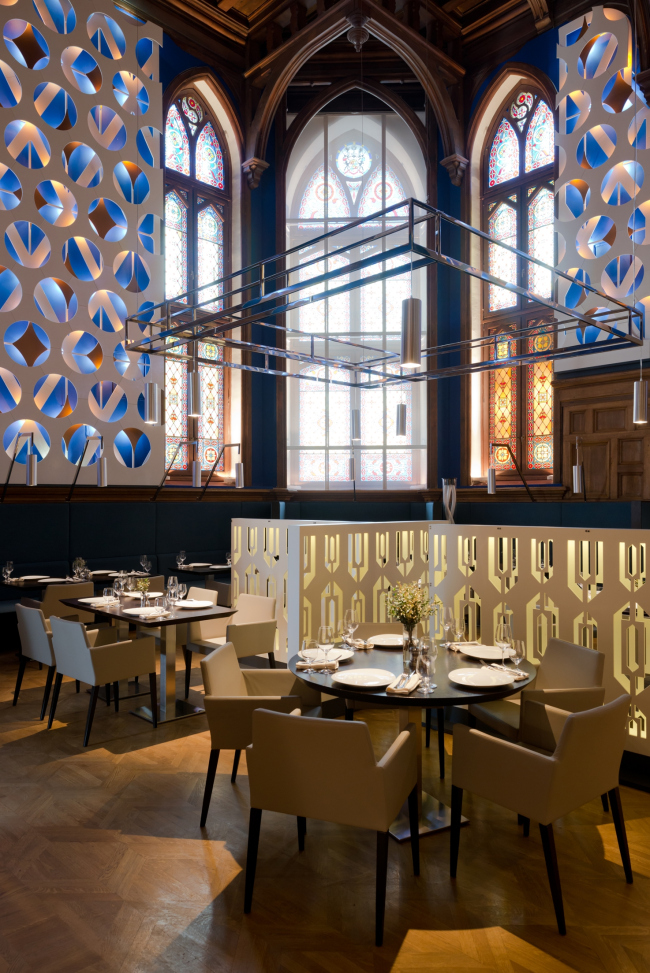
Reconstruction of the restaurant of the Central House of Writers © WOWHAUS
For example, the walls of the foyer that is the first to greet the guests if the restaurant - the architects re-painted them gray-blue, applying to this background a lot of circles with light-reflecting properties. Appearing here for the first time, the circle becomes the theme that runs through all the premises of the restaurant - this is generally one of the favorite techniques of WOWHAUS, and, one must say that it in the interior it sounds a lot more intimately than it does in the decoration of public outdoor areas.
The stairway that leads from the foyer to the restaurant, also underwent complete transformation. In order to give this structure a less massive look, the architects installed on each stair snow-white triangular frames with a backlight. Following the shift of the steps, these structures form an imposing-looking perspective portal: leading into the main premises of the restaurant, it unambiguously warns the guests not only about the drastic change of image of the place but also about the very nature of the transformation that occurred.
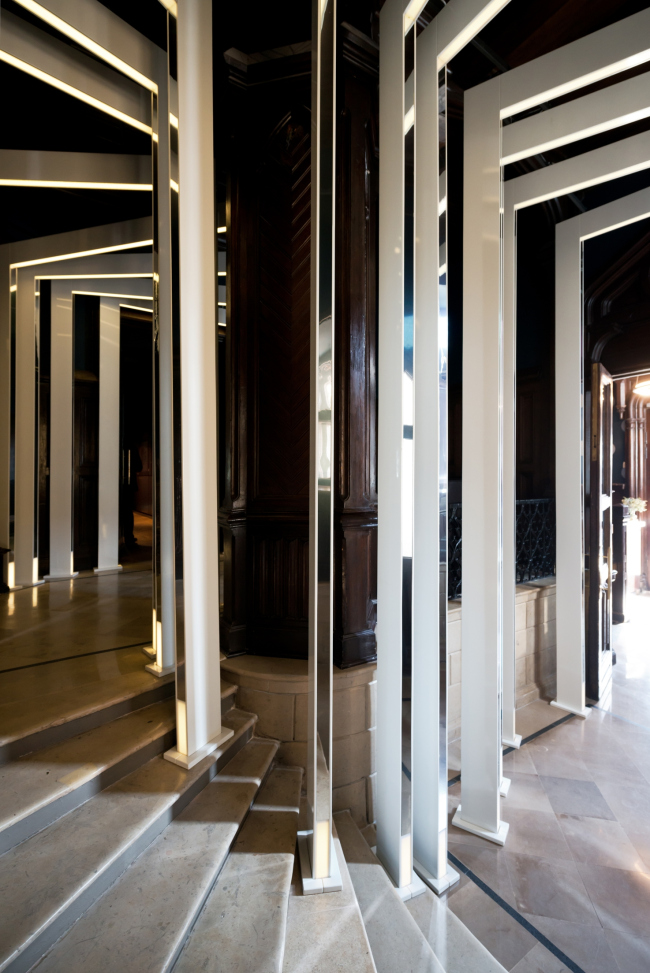
Reconstruction of the restaurant of the Central House of Writers © WOWHAUS
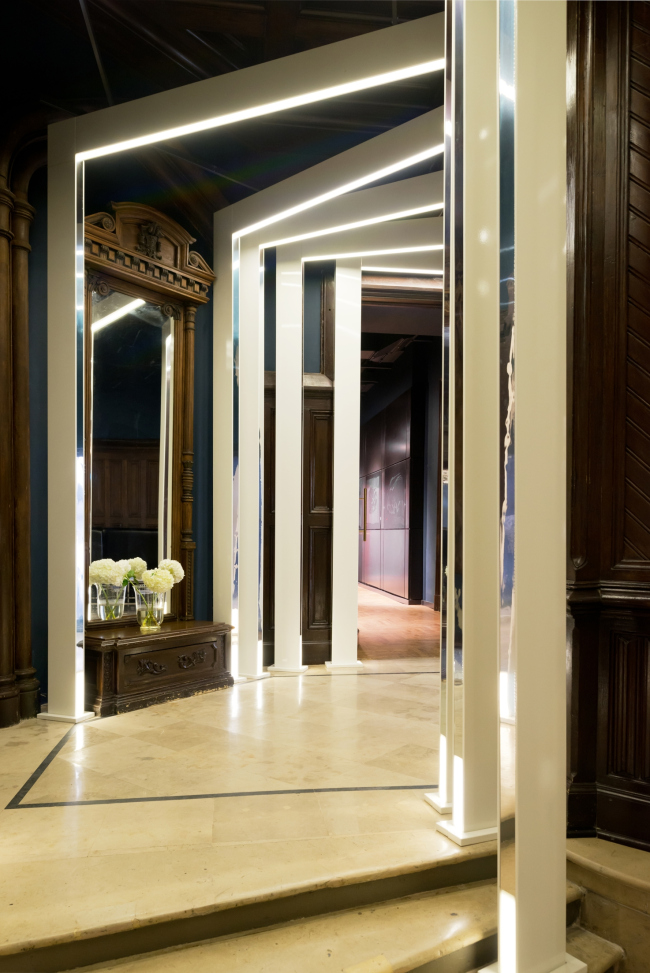
Reconstruction of the restaurant of the Central House of Writers © WOWHAUS
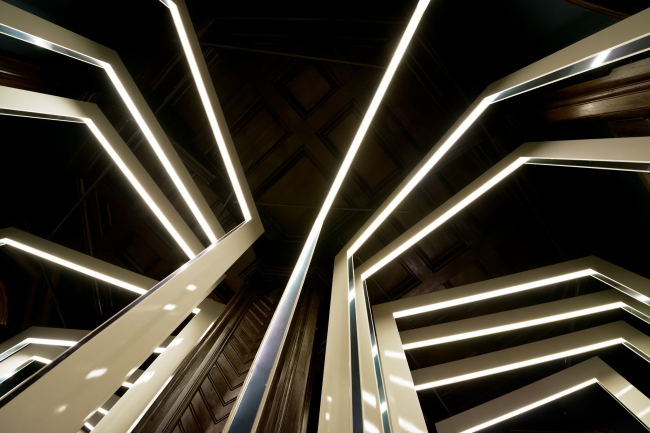
Reconstruction of the restaurant of the Central House of Writers © WOWHAUS
In thus sense, the corridors of the restaurant look particularly expressive. Their ceilings conceal the air chutes and ventilation ducts, while below them there are there is a layer of cylinder-shaped lights. They not only conceal the chutes but also make the ceiling look lower, giving extra intrigue to the passes from one hall to another.
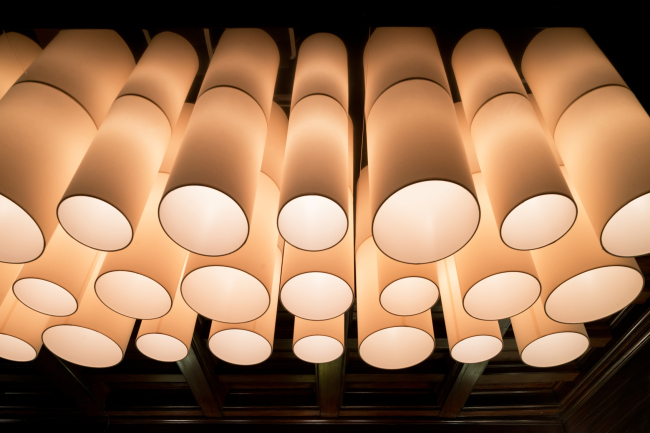
Reconstruction of the restaurant of the Central House of Writers © WOWHAUS
The mantel rooms of the CHW, although situated on different floors, are still designed in the similar fashion. Their design uses multiple repeating elements: the same circles and the repeating damask pattern. At the same time, in the lower room, the latter - yet another "genre classic" for neogothic - serves as the background, upon which panels with perforation in the form of circles are applied. Also interesting is the fact that the architects also backlight their multilayer plastic panels with blue light, thus attracting all the visitors' attention to them and making a diversion from the heavyweight decoration if the premises. In the upper hall, these same elements become flat, repeating themselves in the pattern of the wallpaper. The wall lights continue to develop the "circle" theme as the leitmotif of the restaurant's decoration, while the main lighting is provided by the suspended chandelier that consists of a multitude of cylinders.
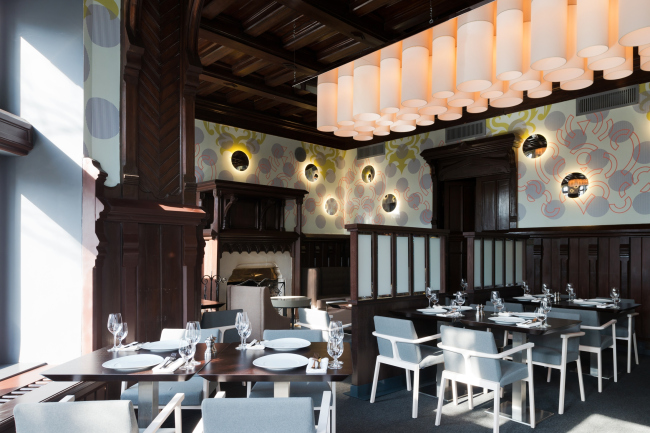
Reconstruction of the restaurant of the Central House of Writers © WOWHAUS

Reconstruction of the restaurant of the Central House of Writers © WOWHAUS
Probably, the place where the concept of a modern layer freely laid over the historical one manifests itself the most is the Oak Hall. Here, again, the task was to distract the guests from the all-too-high-brow interior, and the architects decorate the oak panels with a glittering pattern. Interesting is the fact that these screens run along the perimeter of the hall on a level with the faces of the people sitting behind the tables, which all the more enhances the independence and conditional status of the new "layer". The two-layer perforated false walls from MDF are decorated with a pattern that repeats, in an exaggerated way, the patterns of this hall's main pride - the immense stained-glass window. The outer layer is cut through with circles, and the outer layer - with diamonds, and they are backlit by a warm yellow glow that creates a peculiar play of geometric shapes that echoes the play of light in the stained glass.
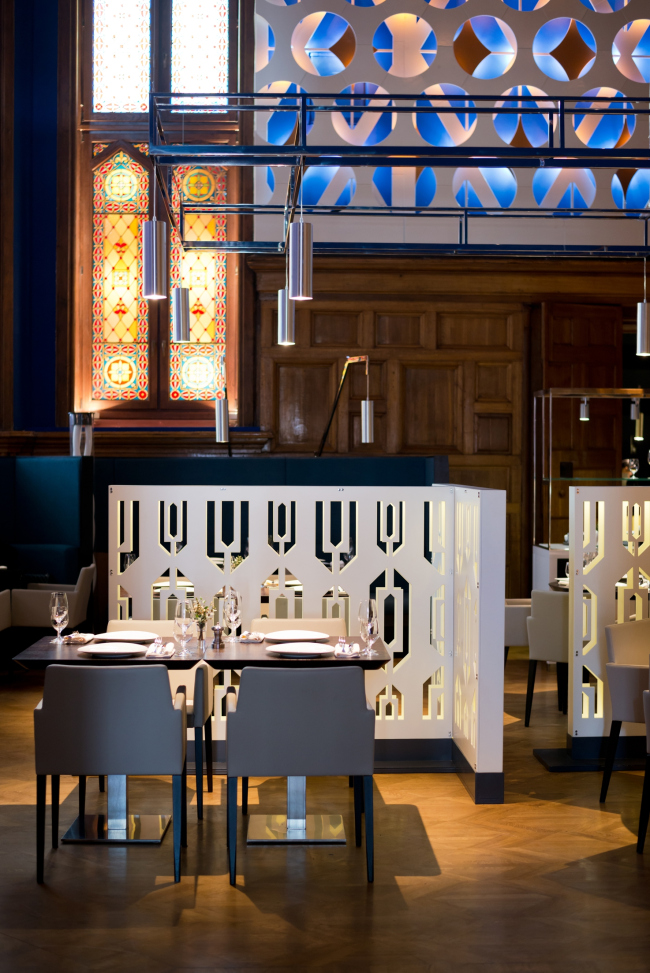
Reconstruction of the restaurant of the Central House of Writers © WOWHAUS
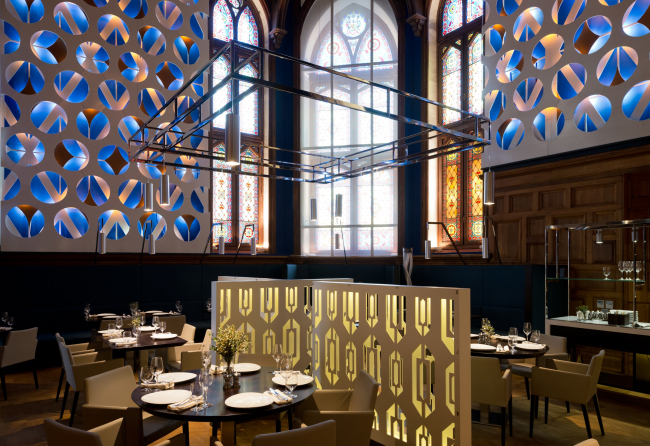
Reconstruction of the restaurant of the Central House of Writers © WOWHAUS
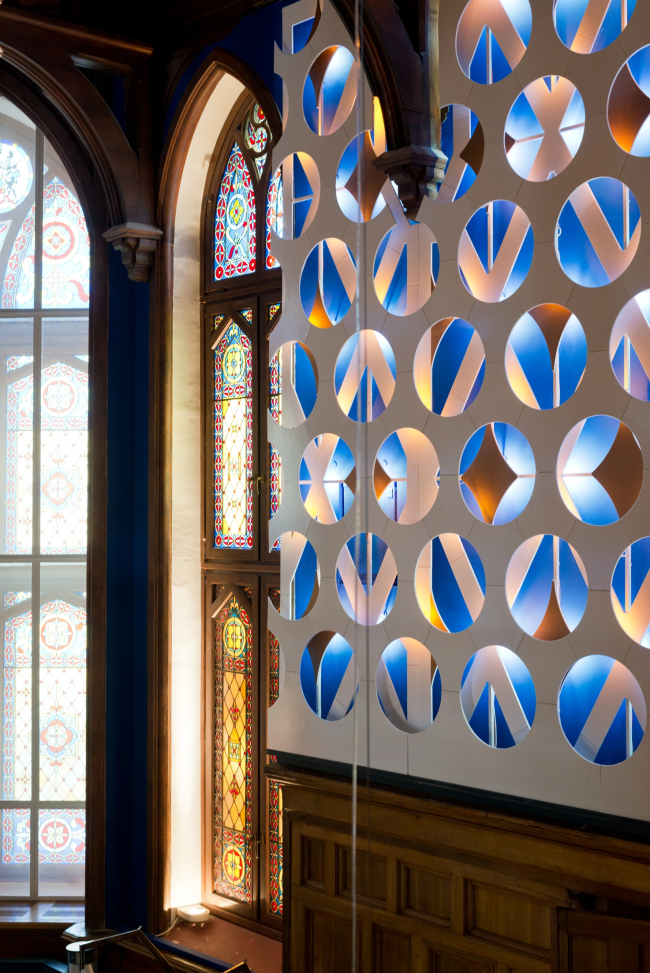
Reconstruction of the restaurant of the Central House of Writers © WOWHAUS
Besides, the hall has in it white separation screens - white backlit partitions, also made from MDF and perforated with a pattern that freely interprets the neogothic language. In order to visually shrink a little the double-height hall and create here a more intimate atmosphere, the architects used, for lighting the tables, bulb lights suspended in a metal framework. In the central zone they are mounted onto the ceiling, while in the couch area they are fastened on the tall couch backs. As was already said, the architects were also able to preserve the CHW's special pride - the immense crystal chandelier: on the level of the second tier, the architects installed a huge panel picture dedicated to good, the very magnitude of which rhymes with the glory of the chandelier.
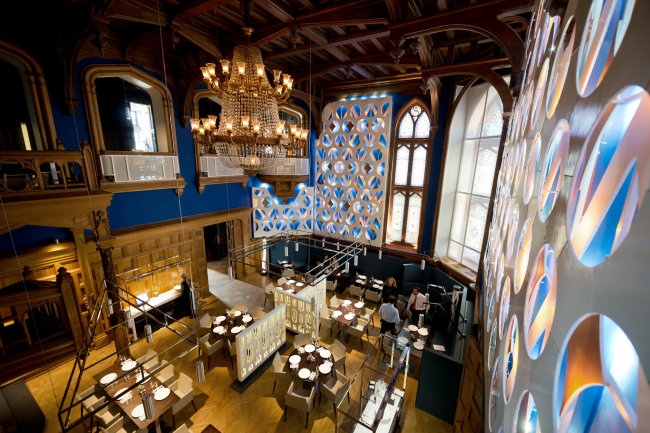
Reconstruction of the restaurant of the Central House of Writers © WOWHAUS
Developed by WOWHAUS, the concept of renovating the interior of the famous restaurant did not get universal critical acclaim: some people, to be sure, shudder at the very idea of marrying the "sturdy" wood and the plastic that does not even make an attempt to pay a lip service to this noble material. Probably, if one takes transformation seriously, such complaints would have made sense - but the key to understanding this interior lies in the very fact that one needs to realize that this renovation was not done "for ages to come". "The pattern was based on the "golden shields against the azure field" - almost childish interpretation of the chivalrous heraldry - Dmitry Likin explains - applied to the decorative panels, it starts to play with the pseudo-gothic historical interior, destroying its grandeur and thus performing its main task of creating a light and sharp-witted space".
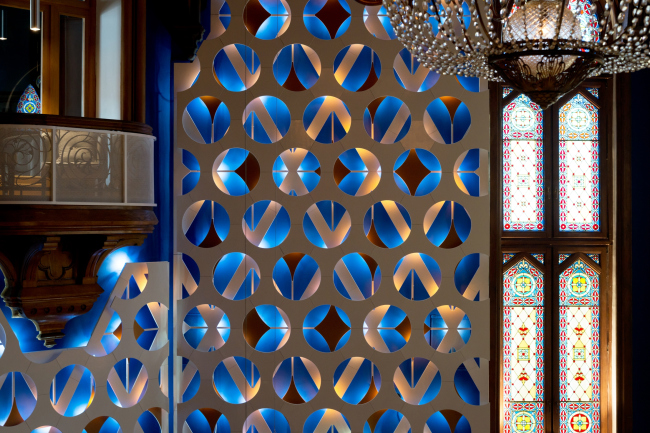
Reconstruction of the restaurant of the Central House of Writers © WOWHAUS
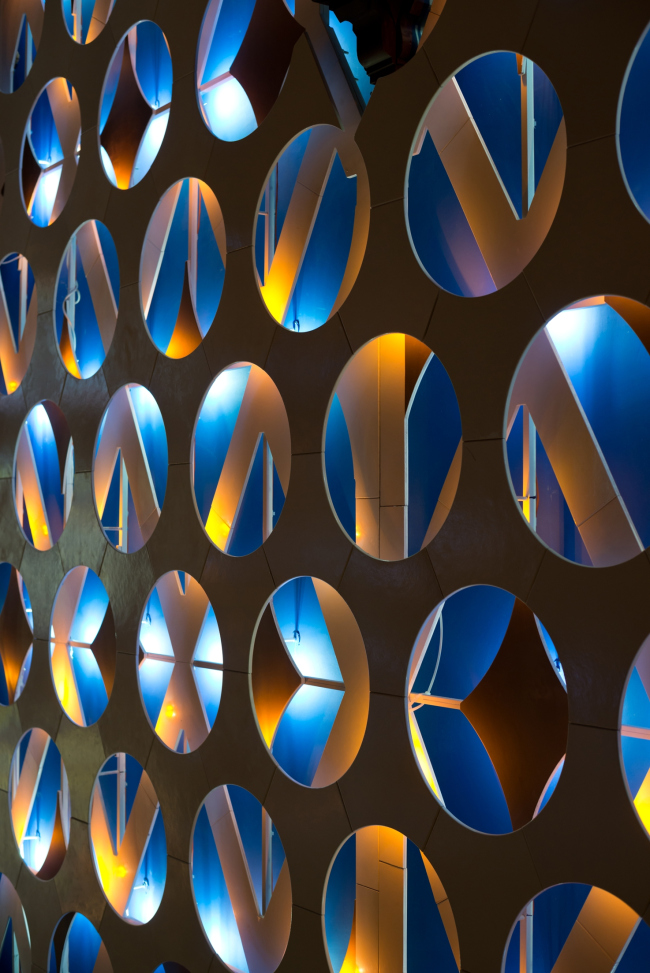
Reconstruction of the restaurant of the Central House of Writers © WOWHAUS
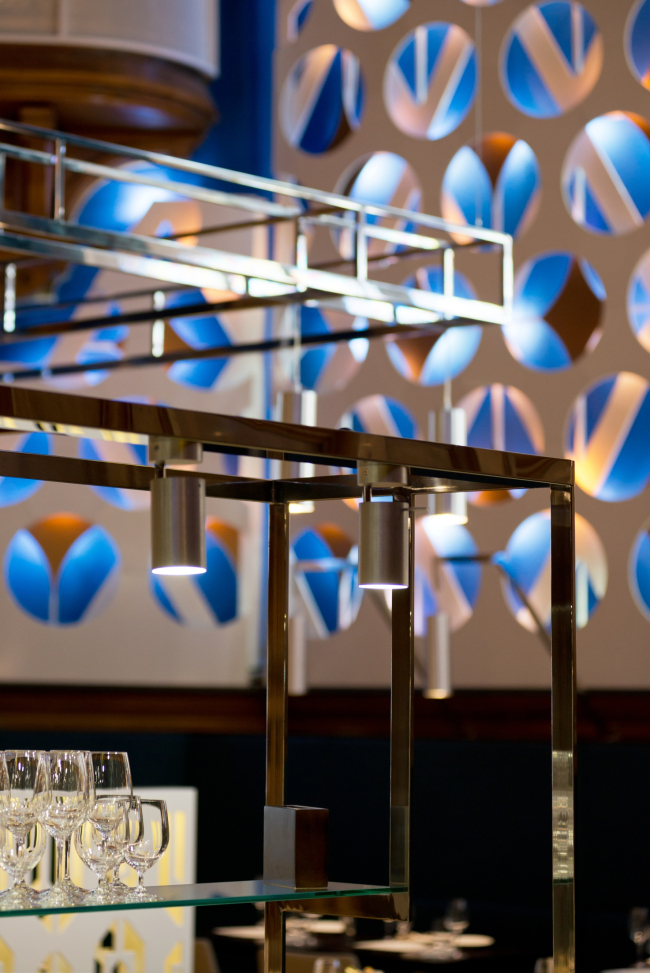
Reconstruction of the restaurant of the Central House of Writers © WOWHAUS
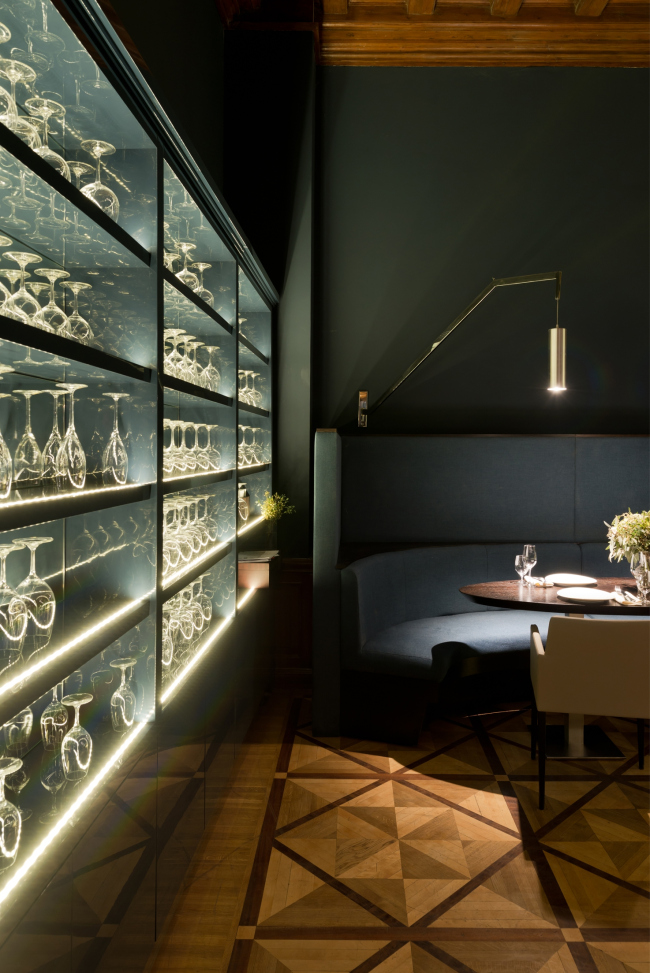
Reconstruction of the restaurant of the Central House of Writers © WOWHAUS
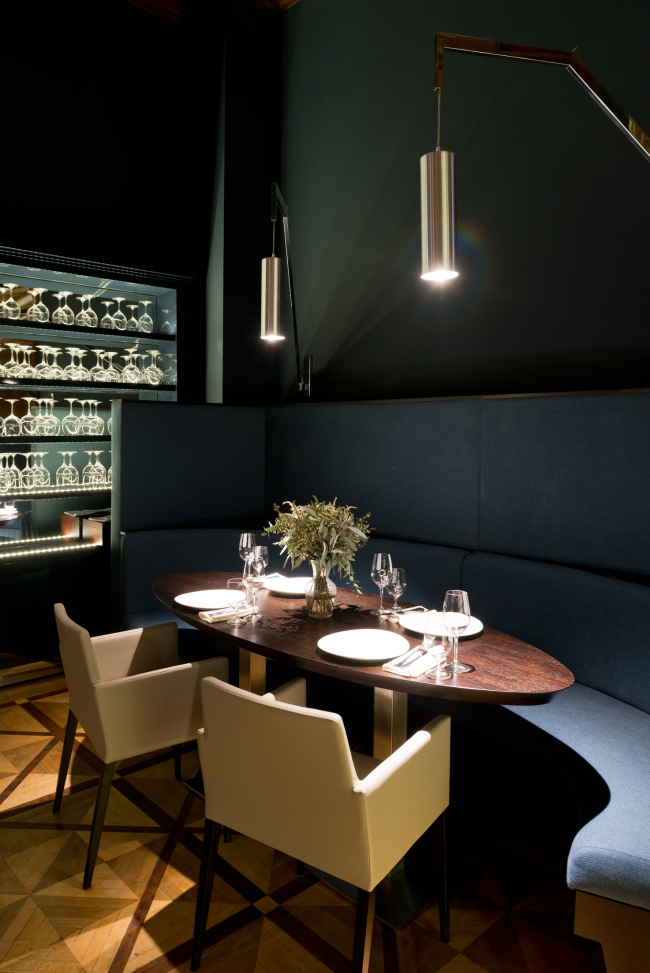
Reconstruction of the restaurant of the Central House of Writers © WOWHAUS
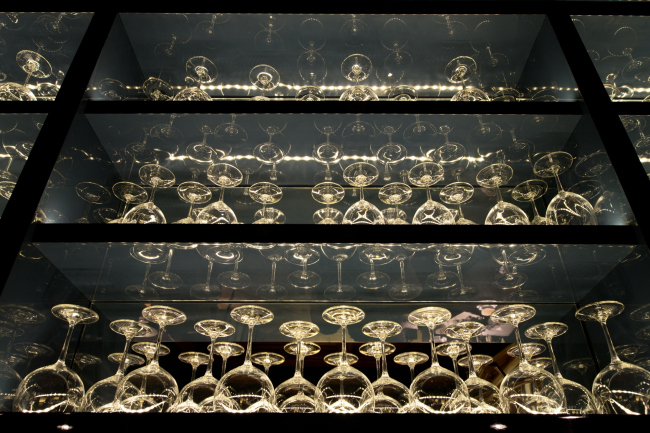
Reconstruction of the restaurant of the Central House of Writers © WOWHAUS
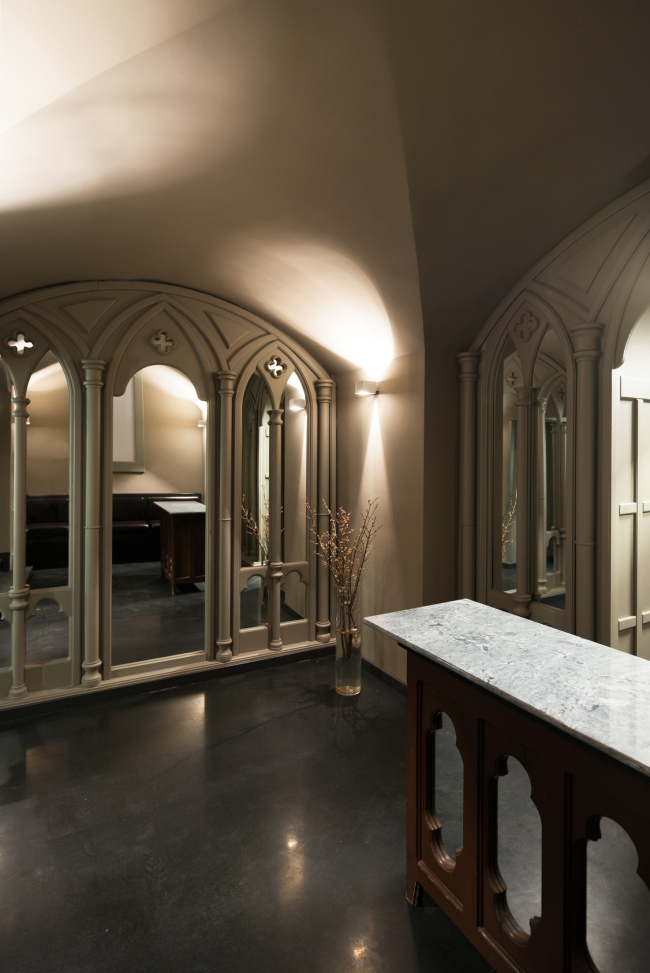
Reconstruction of the restaurant of the Central House of Writers © WOWHAUS
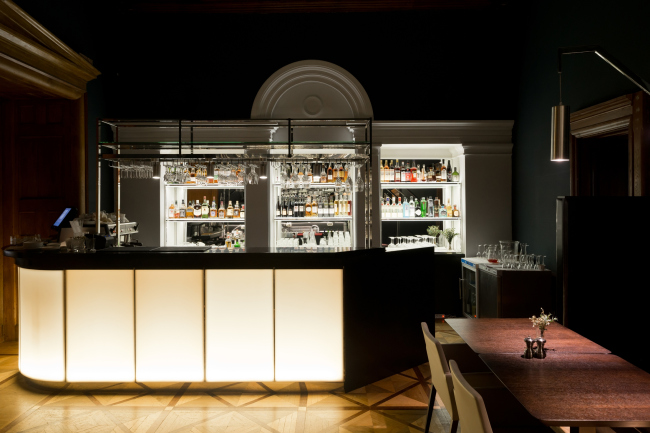
Reconstruction of the restaurant of the Central House of Writers © WOWHAUS















